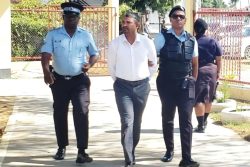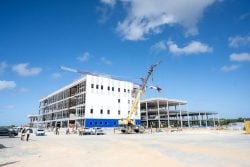Vice President Bharrat Jagdeo told a press conference on Thursday that all partners in the Stabroek Block have contributed their respective shares to the US$600 million per project insurance and currently possess the necessary lawful certification, even as they begin wrapping up an agreement with the Environmental Protection Agency (EPA) for a parent guarantee agreement.
“They said that they are in the final stages of concluding the parent guarantee. So they are working on it and I anticipate it would be a matter of weeks before they conclude… They said they are a matter of weeks from getting the parent guarantee,” Jagdeo said.
The IHS Markit audit report of oil expenditures by ExxonMobil’s subsidiary Esso Exploration and Production Guyana Limited (EEPGL) and its partners, covering the period 1999 to 2017, had stated that the oil companies were operating in breach of the insurance requirement of the Production Sharing Agreement (PSA). According to the report, none of the three – EEPGL, Hess Corp and China National Offshore Oil Corporation (CNOOC) – provided insurance certificates to show liability coverage. Questionable insurance coverage in the event of an oil spill or other disasters was debated for years and neither EEPGL nor the government could assuage public concerns.
According to the IHS audit report released in March 2021, “Insurance is required by the PSA, applicable laws, rules, and regulations and of such type and in such amount as is customary in the international petroleum industry in accordance with good oilfield practice appropriate for Petroleum Operations. EEPGL stated that each partner, EEPGL, Hess and CNOOC carry insurance cover for their respective interests in the PSA. Copies of insurance certificates have not been provided by any partner, contrary to the PSA requirement.”
Jagdeo said that US$600 million per occurrence was worked out last year and that the insurance certificate had been issued. But, he said, the companies had to agree among themselves on the ratio of contribution to the US$600 million sum, and with that being established, they are now working on the parent guarantee aspect in which they and the EPA have to come to an agreement.
With regard to the insurance breach, ExxonMobil explained to the auditors that its two partners – CNOOC and Hess – were to have taken up their respective share of the insurance costs, as per their percentage interest in the block, but there were no records from the two companies indicating that they had even started the process. “Insurance certificates have not been provided to ensure that full coverage has been maintained throughout the audit period. Each partner procures coverage for its share of the block interest, only EEPGL has provided details and invoices. It has not been able to confirm that Hess and CNOOC are meeting their responsibilities in this regard,” the audit report said. It highlighted that EEPGL had submitted some invoices for insurance premiums it bought from a United Kingdom insurance company and that EEPGL was working with another to set the premium rates for work here.
According to the report, ExxonMobil maintained its 45% share of Control of Wells (CoW), Operators Extra Expense (OEE) and Third Party Liability (TPL) insurance coverage through a wholly owned subsidiary of ExxonMobil, Ancon Insurance. “Although wholly owned, Ancon Insurance acts as a separate company at sufficient arm’s length from ExxonMobil. EEPGL provided evidence of Ancon Insurance consulting with an external insurance consultant, Jardine Lloyd Thompson, to set premium rates for Guyana,” the report pointed out. Of the premiums for insurance coverage and invoices submitted and reviewed by the auditors, the report said, the total amounts paid by EEPGL fell within expected industry norms. A lump sum was added to the company’s cost recovery statement in 2017.
The IHS report stated that ExxonMobil included insurance premiums paid by Hess, but did not provide information on what timeframes those payments covered. The report further stated: “It is not clear that Hess and CNOOC have maintained insurance coverage… or no premiums have been identified.” Without any record of insurance by the co-venture partners, the report asserted that the Government of Guyana was left exposed and ran a risk should recovery of those sums ever be needed. “The lump sum added to the Cost Recovery Statement in 2017 included insurance premium payments by Hess and CNOOC in 2015 but no information has been provided as to which time frames these amounts covered. The General Ledger does not include any premiums paid by either party for 2016 or 2017. No evidence has been provided that either Hess or CNOOC are maintaining insurance cover and are therefore contravening the PSA requirements…,” the report stated.
The issue of insurance and liability coverage had seen ExxonMobil’s Liza Phase 2 project in the Stabroek Block project hit a snag in 2019, as the EPA was not satisfied that the language used in the company’s application clearly stated the amounts that had to be covered above the insurance. Having documentation to support insurance coverage had been underscored by the former head of the EPA Dr Vincent Adams in February 2019 when he reported that EEPGL had submitted proof of insurance coverage of up to US$2 billion through a United Kingdom company, but that the agency had instead asked for parent company coverage.






